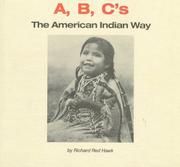
Presents the letters from A to Z, using each letter to introduce the culture, customs, and history of the North American Indians.

Presents the letters from A to Z, using each letter to introduce the culture, customs, and history of the North American Indians.
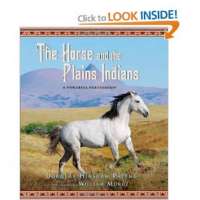
The image of a Native American on horseback has become ingrained in the American consciousness. But the Plains Indians and the horse were not always inseparable. Once, Native Americans used dogs to help carry their goods, and even after the Spaniards introduced the horse to the Americas, horses were considered so valuable that the Spanish would not allow the Indians to have them. But soon horses escaped from Spanish settlements, and Native Americans quickly learned how valuable the horse could be as a hunting mount, beast of burden, and military steed. Follow the story of this transformative partnership, starting in the early sixteenth century and continuing today.
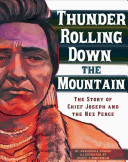
“In graphic novel format, explores the battles and hardships faced by Chief Joseph and the Nez Perce when they were forced to leave their homelands”–Provided by publisher.
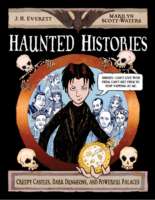
Guided by tween “ghostorian” Virgil, readers will discover fascinating facts about calamitous events throughout history as they explore castles, palaces and dungeons and those infamous figures associated with each. For instance, did you know that many castles were made out of wood painted to look like stone? Or that wealthy prisoners in the Tower of London could keep servants? The book is chock-full of details that kids will find intriguing–dungeon life for prisoners, methods of turture, and even the most popular methods of poisoning enemies. So join Virgil and the other ghostly inhabitants for an historical adventure on the dark side.
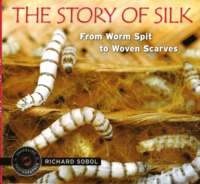
Join author and photographer Richard Sobol as he picks up his camera once more and travels to a small village in Thailand for an in-depth exploration of the story of silk and the labor-intensive process of making it. From nurturing the silkworms to weaving the fabric and photographing the children as they proudly model the finished product, this first-person narrative, illustrated with richly detailed photographs, chronicles the amazing process of creating one of history’s most desired textiles.
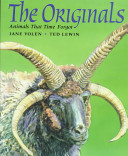
They’re weird. They’re unusual. They have four horns and shaggy red fur. And they haven’t changed in hundreds, even thousands of years! They’re the originals–animals that, unlike their barnyard relatives, never evolved from their primitive states. Come meet the four-horned Hebridean sheep, brought to Scotland by Viking raiders, the tiny Exmoor ponies that roam the fog-filled moors of England, and the rest of these modern ancients. Jane Yolen’s childlike story poems and Ted Lewin’s light-infused water-color illustrations capture all the mystique of these remarkable animals.
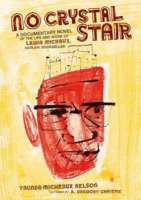
A documentary novel of the life and work of Lewis Michaux, Harlem bookseller
‘You can’t walk straight on a crooked line. You do you’ll break your leg. How can you walk straight in a crooked system?’
Lewis Michaux was born to do things his own way. When a white banker told him to sell fried chicken, not books, because Negroes don’t read,’ Lewis took five books and one-hundred dollars and built a bookstore. It soon became the intellectual center of Harlem, a refuge for everyone from Muhammad Ali to Malcolm X.
In No Crystal Stair, Coretta Scott King Award-winning author Vaunda Micheaux Nelson combines meticulous research with a storyteller’s flair to document the life and times of her great uncle Lewis Michaux, an extraordinary literacy pioneer of the Civil Rights era.
‘My life was no crystal stair, far from it. But I’m taking my leave with some pride. It tickles me to know that those folks who said I could never sell books to black people are eating crow. I’d say my seeds grew pretty damn well. And not just the book business. It’s the more important business of moving our people forward that has real meaning.’
See the review at WOW Review, Volume 5, Issue 1
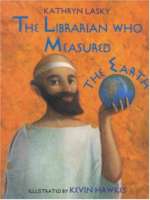
Describes the life and work of Eratosthenes, the Greek geographer and astronomer who accurately measured the circumference of the Earth.
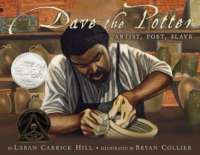
To us it is just dirt, the ground we walk on…But to Daveit was clay, the plain and basic stuffupon which he formed a lifeas a slave nearly 200 years ago. Dave was an extraordinary artist, poet, and potter living in South Carolina in the 1800s. He combined his superb artistry with deeply observant poetry, carved onto his pots, transcending the limitations he faced as a slave. In this inspiring and lyrical portrayal, National Book Award nominee Laban Carrick Hill’s elegantly simple text and award-winning artist Bryan Collier’s resplendent, earth-toned illustrations tell Dave’s story, a story rich in history, hope, and long-lasting beauty.
I, Galileo Galilei, am old and can no longer see, but there was a time I saw all the way to the stars–the moon, the planets, the sun. Their movements showed me a truth so profound, it changed our view of the entire universe. A truth so unpopular, it would get me into a world of trouble.
Galileo’s inventions and insights were so great that Einstein called him the “father of modern science.” But in his own time, Galileo’s idea of a sun-centered solar system was considered radical and even dangerous–he was branded a heretic, imprisoned in his ome, and banned from discussing science with anyone. In this inspired biopgraphy, Bonnie Christensen lets Galileo himself tell the tale–and his genial narration makes this giant of science feel more real and accessible than ever before. Lavishly illustrated in rich jewel tones, this is a perfect introduction to a most remarkable man.